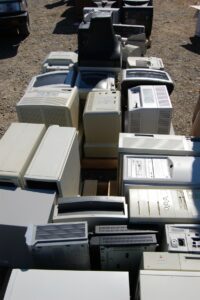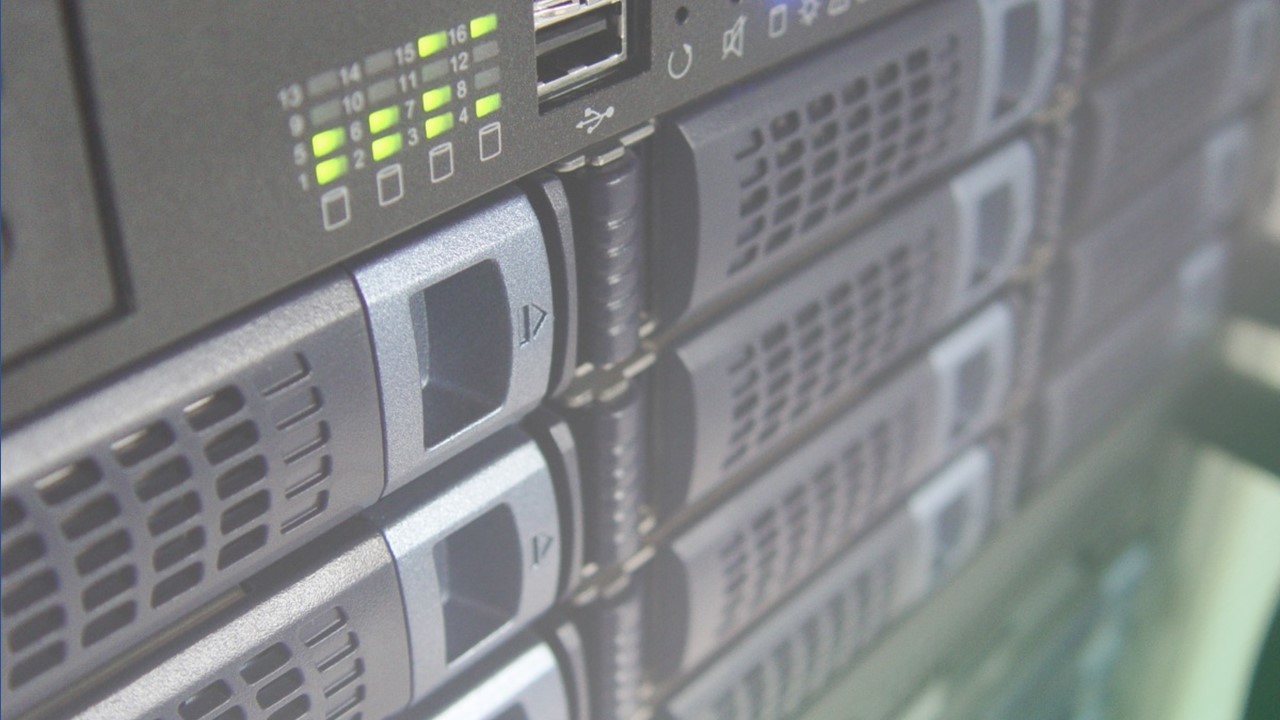Information technology (IT) has revolutionised the way we live and work. It has made communication and access to information faster and easier than ever. However, the growth of IT has also come with significant environmental impacts. It is the source of substantial amounts of carbon dioxide (CO2) and other harmful emissions. In recent years, the environmental impact of IT has become a significant concern, and organisations are increasingly pressured to reduce their carbon footprint and minimise the environmental externalities associated with IT.
Does Information Technology Affect the Environment?
Figures from Lancaster University indicate that computing emissions account for 2.1-3.9% of all greenhouse gases spewed into the atmosphere. This can be compared with air travel, which accounts for about 2.5 per cent. This is a significant amount of CO2 and other emissions. Particularly considering the rapid growth of the IT industry in recent years and the expected increase in the years to come. Besides CO2 emissions, IT is also responsible for many other environmental externalities. This includes using finite resources such as metals, plastics, and rare earth minerals. The IT industry also produces e-waste, which can contain toxic materials and harm the environment.
Data centres, which comprise a substantial part of computing, consume 4-6% of the world’s electricity. Personal computing and Blockchain each stand for about 1% of the world’s electricity consumption. Energy consumption is expected to increase dramatically in the future. With the annual increase, computing in 2040 is likely to consume as much electricity as the total production of 2020. That, of course, assumes that consumption will continue to increase at the present speed.
E-Waste
 Once computers, servers, and other electronic devices have reached their end of life, they typically become e-waste. E-waste is expected to reach 110 million tons by 2050, making it one of the fastest-growing waste streams. The most toxic ingredient in e-waste can vary depending on the product and the materials used in its construction. However, some of the most poisonous materials commonly found in e-waste include:
Once computers, servers, and other electronic devices have reached their end of life, they typically become e-waste. E-waste is expected to reach 110 million tons by 2050, making it one of the fastest-growing waste streams. The most toxic ingredient in e-waste can vary depending on the product and the materials used in its construction. However, some of the most poisonous materials commonly found in e-waste include:
- Lead: Lead is a heavy metal used in various electronic components, including batteries and computer monitors. When not properly disposed of, lead can contaminate the soil and water and cause serious health problems, particularly for children and pregnant women.
- Mercury: Mercury is a toxic heavy metal in switches and LCD screens. When not properly disposed of, mercury can enter the food chain and cause health problems for wildlife and humans.
- Cadmium: Cadmium is a heavy metal that is used in rechargeable batteries. Like lead and mercury, cadmium is toxic and can cause health problems if improperly disposed of.
- Beryllium: Beryllium is a metal used in computer components and can cause lung problems if inhaled.
- Polychlorinated Biphenyls (PCBs): PCBs are chemicals used in electrical equipment and can cause cancer, congenital disabilities, and other health problems.
These are just a few examples of the toxic materials in e-waste from computers. E-waste may also contain a range of other hazardous materials. These include flame retardants and toxic plastics, which can also harm the environment and human health if not disposed of properly. Organisations must minimise the environmental impact of e-waste by taking a responsible approach to the disposal of their electronics and adequately recycling or disposing of their waste to minimise harm to the environment and human health.
Need for change
In light of these environmental impacts, it is clear that the IT industry must take proactive steps to minimise its impact on the environment. This includes reducing CO2 emissions, optimising resource usage, and reducing waste. By doing so, organisations can help ensure a more sustainable future for the industry and the planet.
Why Green IT?
Green IT is the responsible use of information technology to minimise environmental impact. This includes reducing energy consumption and waste, optimising resource usage, and increasing sustainability in all areas of information technology. In today’s rapidly changing business landscape, companies face the challenge of reducing their carbon footprint while maintaining competitiveness and growth. Green IT can help organisations meet this challenge by providing a way to use information technology with a minimum environmental footprint. In addition, as users of information technology become more aware of the impact, they will demand reduced footprint and transparency. Companies that move ahead and reduce their footprint will get an advantage.
How can companies reduce their environmental footprint?
One of the most significant ways to reduce the environmental impact is by optimising the use of resources. Here are some examples:
- Using virtual meeting tools to minimise the need for business travel
- Using cloud computing to reduce the amount of physical hardware and energy required to store and process data
- Using power-saving features and sleep modes on computers and other devices.
- Locating data centres in colder areas, where the cost of cooling would be lower and where the heat can be used for central heating of residential areas.
In addition, companies can also reduce the environmental impact of their IT operations by using renewable energy sources, such as solar or wind power, to power their data centres and other IT facilities.
Energy Efficiency
One of the most effective ways a company can use IT with a minimum environmental footprint is by implementing energy-efficient practices. This can include using energy-efficient hardware, such as computers, servers, and storage devices, and optimising energy usage through power management software and settings. Companies can also reduce energy consumption by utilising virtualisation technologies, which enable multiple applications and services to run on a single physical server, thereby reducing the need for multiple servers and associated energy consumption.
Since cooling accounts for 30-55% of a data centre’s electricity consumption, selecting a location with a sustainable energy supply or one where the outside temperature is lower, and local air and water can be used to cool servers, would dramatically reduce electricity consumption.
Reducing waste
One way to minimise the environmental impact of IT is to reduce the amount of industry-generated waste. The individual IT company can ensure that they buy IT equipment with a longer lifespan. Virtualisation can also reduce the number of servers while increasing the utilisation of each device. Manufacturers should design IT products with sustainability in mind. This includes using environmentally friendly materials and reducing the size and weight of appliances. Companies can also reduce waste by adopting a circular economy approach, which involves designing products that can be easily reused, repaired, or recycled. This not only helps to reduce waste but also minimises the use of finite resources and promotes a more sustainable future.
Environmental transport
Companies can and should also use IT to promote sustainability by encouraging environmentally friendly modes of transportation and promoting telecommuting. For example, by allowing employees to work from home, companies can reduce the number of commuter trips, resulting in reduced traffic congestion, reduced emissions, and a more sustainable future.
What we have done at Gislen Software
At Gislen Software, we utilise solar panels, which generate approximately 40% of our electricity. We have improved the isolation. Gislen Software has its development facility in Tamil Nadu. This is the Indian State with the highest amount of wind, nuclear, and the second-highest solar energy plants compared to other Indian states. Although we still rely on electricity from the grid, transportation to and from the office, and contribute to environmental impact, we offset three times our estimated CO2 emissions through UN-audited projects in India. Hence, we are a carbon-negative company. When you use our services, it likely has a less impact on the environment than if you use the vast majority of IT service providers.
Conclusion
In conclusion, Green IT is a critical aspect of modern business, providing organisations with a way to use information technology with a minimum environmental footprint. From optimising existing resources and reducing waste to implementing energy-efficient practices and promoting sustainability, there are many ways companies can utilise IT to minimise their environmental impact and contribute to a more sustainable future. By taking a proactive approach to Green IT, companies can ensure that their operations are both economically and environmentally sustainable for years to come.
Another article, written by Tom Read – How to Reduce Your Digital Carbon Footprint – And Why You Need To, gives a lot more advice!
Mikael Gislén is the Managing Director of Gislen Software, a Swedish-owned Indian Software development company. Mikael started the company in 1994. Gislen Software provides high-value software development services to Scandinavian, UK and US clients. The company invested in solar panels in 2013 and has been carbon-negative since 2018. Please contact us if you require IT services and are interested in purchasing from a supplier that practices Green IT.
